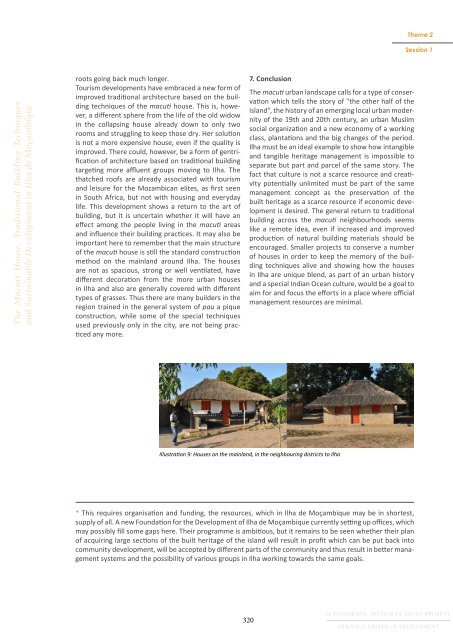PARTIE 2 - Icomos
PARTIE 2 - Icomos
PARTIE 2 - Icomos
You also want an ePaper? Increase the reach of your titles
YUMPU automatically turns print PDFs into web optimized ePapers that Google loves.
Theme 2<br />
Session 1<br />
The Macuti House, Traditional Building Techniques<br />
and Sustainable Development in Ilha de Moçambique<br />
roots going back much longer.<br />
Tourism developments have embraced a new form of<br />
improved traditional architecture based on the building<br />
techniques of the macuti house. This is, however,<br />
a different sphere from the life of the old widow<br />
in the collapsing house already down to only two<br />
rooms and struggling to keep those dry. Her solution<br />
is not a more expensive house, even if the quality is<br />
improved. There could, however, be a form of gentrification<br />
of architecture based on traditional building<br />
targeting more affluent groups moving to Ilha. The<br />
thatched roofs are already associated with tourism<br />
and leisure for the Mozambican elites, as first seen<br />
in South Africa, but not with housing and everyday<br />
life. This development shows a return to the art of<br />
building, but it is uncertain whether it will have an<br />
effect among the people living in the macuti areas<br />
and influence their building practices. It may also be<br />
important here to remember that the main structure<br />
of the macuti house is still the standard construction<br />
method on the mainland around Ilha. The houses<br />
are not as spacious, strong or well ventilated, have<br />
different decoration from the more urban houses<br />
in Ilha and also are generally covered with different<br />
types of grasses. Thus there are many builders in the<br />
region trained in the general system of pau a pique<br />
construction, while some of the special techniques<br />
used previously only in the city, are not being practiced<br />
any more.<br />
7. Conclusion<br />
The macuti urban landscape calls for a type of conservation<br />
which tells the story of "the other half of the<br />
island", the history of an emerging local urban modernity<br />
of the 19th and 20th century, an urban Muslim<br />
social organization and a new economy of a working<br />
class, plantations and the big changes of the period.<br />
Ilha must be an ideal example to show how intangible<br />
and tangible heritage management is impossible to<br />
separate but part and parcel of the same story. The<br />
fact that culture is not a scarce resource and creativity<br />
potentially unlimited must be part of the same<br />
management concept as the preservation of the<br />
built heritage as a scarce resource if economic development<br />
is desired. The general return to traditional<br />
building across the macuti neighbourhoods seems<br />
like a remote idea, even if increased and improved<br />
production of natural building materials should be<br />
encouraged. Smaller projects to conserve a number<br />
of houses in order to keep the memory of the building<br />
techniques alive and showing how the houses<br />
in Ilha are unique blend, as part of an urban history<br />
and a special Indian Ocean culture, would be a goal to<br />
aim for and focus the efforts in a place where official<br />
management resources are minimal.<br />
Illustration 9: Houses on the mainland, in the neighbouring districts to Ilha<br />
* This requires organisation and funding, the resources, which in Ilha de Moçambique may be in shortest,<br />
supply of all. A new Foundation for the Development of Ilha de Moçambique currently setting up offices, which<br />
may possibly fill some gaps here. Their programme is ambitious, but it remains to be seen whether their plan<br />
of acquiring large sections of the built heritage of the island will result in profit which can be put back into<br />
community development, will be accepted by different parts of the community and thus result in better management<br />
systems and the possibility of various groups in Ilha working towards the same goals.<br />
320<br />
LE PATRIMOINE, MOTEUR DE DÉVELOPPEMENT<br />
HERITAGE, DRIVER OF DEVELOPMENT

















